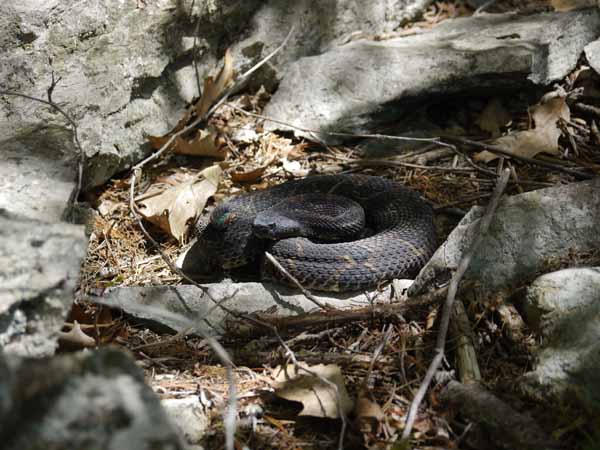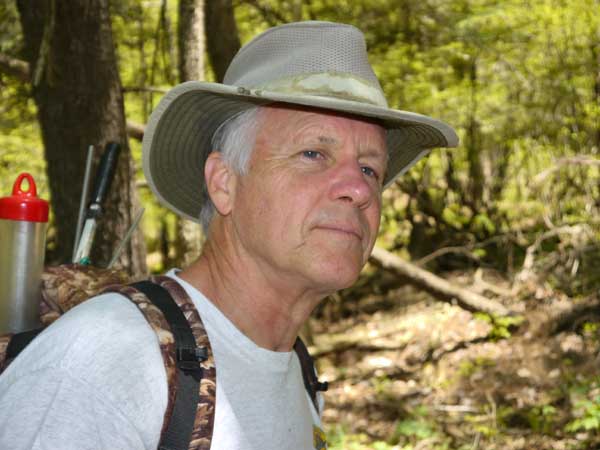By Matt Miller, senior science writer
Here’s what you quickly learn about rattlesnake researchers: They’re fearless, but pay obsessive attention to safety. They watch their step. And they keep their mouths shut.
In fact, when I joined snake researchers in the field in Vermont, I was practically sworn to secrecy. They asked that I promise not to reveal specific locations where snakes were found, or use any photos with revealing landmarks. Snake researchers are silent.
For good reason: they do not want their research to endanger the rattlesnakes they’re trying to conserve.
Snakes should fear us more than we fear them. Snake researchers know this. They were far more anxious about people discovering their research sites than they were about handling venomous snakes.
It’s no secret that people have strong (and some have argued innate) feelings about snakes. Some take those feelings and act on them. There are those who hate snakes and round them up, shoot them, spray gasoline down their dens. There are others who love snakes, who want to interact with them, who want them as pets, who want to play Croc Hunter.
Both the snake haters and the snake lovers can harm reptile populations, including Vermont’s endangered timber rattlesnakes.
That’s why the researchers I recently accompanied – part of a project between the Vermont Department of Fish and Wildlife, the Orianne Society and The Nature Conservancy—were so secretive. They knew that some people would follow them to research sites, causing potential havoc for vulnerable timber rattlers.
Vermont paid a bounty on timber rattlesnakes until 1981, so there are still those who not only kill snakes, but consider it something of a civic duty.
And while it may seem difficult to believe for those who consider pets to be cuddly animals like guinea pigs and golden retrievers, there are those who want to own rattlesnakes. Some individuals follow researchers to snake hibernation sites, record the location using GPS and then sell the coordinates to reptile pet enthusiasts. (For an excellent account of the scope of global reptile trafficking, I recommend Bryan Christy’s book, The Lizard King).
“Rattlesnakes live for 20 to 40 years, and have low reproductive rates,” says Chris Jenkins, executive director of the Orianne Society, an organization devoted to reptile conservation. “Removing or killing adults is one of the very worst things you can do to a population.”
But some want to interact with snakes for less nefarious purposes. They are fascinated by these creatures and just want to see them (and sometimes, handle them). “Many people want to go to a hibernation site just to interact with snakes,” says wildlife biologist Doug Blodgett with the Vermont Department of Fish and Wildlife. “But those interactions can harm snakes and put people at risk.”
Towards a New Relationship with Rattlesnakes

It might seem difficult to override our feelings about snakes. As Edward O. Wilson, David Quammen and others have written, many infants will shriek in terror when shown a snake. Youngsters don’t have such automatic reactions when shown more dangerous objects, like guns or poison. Kids have to be taught to avoid these things. With snakes, there’s an inborn fear—likely from humanity’s time on the savanna when stepping on a venomous snake would have very bad consequences.
The cultural hatred of snakes can run deep. Consider rattlesnake roundups, where people capture snakes (often by using gasoline fumes to flush them out of their dens) and then hold “family events.” Rattlers are subject to all manner of cruelty at these events.
But education can make a difference: in Georgia, the Orianne Society replaced a traditional rattlesnake roundup with an educational festival about snakes. It has been better attended than the previous event.
In Vermont, there are still those who would kill all rattlesnakes given the chance. As I rode through a small town with Blodgett, a large pickup pulled up next to us and hissed “SNAKE!” out the window, this despite Blodgett’s secrecy about the project. Some local residents believe the researchers are stocking snakes, a fairly common conspiracy theory wherever rattlesnakes are found.
Still, most people recognize timber rattlesnakes as an important part of the Appalachian Mountains. They are happy to know the rattlers are out there but don’t need interactions.
But what if a rattlesnake ends up in your backyard? The research partners have been handing out refrigerator magnets and brochures that list licensed snake researchers who will come and safely remove any rattlesnakes.
“It’s making a difference,” says Blodgett. “People know who to call when they have a rattlesnake too close.”
Most people will hike by timber rattlesnakes without even knowing they’re nearby. In fact, even snake researchers often have difficulty finding the snakes, even those with radio transmitters.
If you do see a rattlesnake while out hiking, consider yourself lucky, and enjoy the encounter from a distance. And consider this: While habitat loss, disease and climate change certainly pose risks to timber rattlesnakes, they also continue to be threatened by human ignorance.
So give snakes plenty of space. After facing too many years of relentless persecution and bad human behavior, they deserve it.
Opinions expressed on Cool Green Science and in any corresponding comments are the personal opinions of the original authors and do not necessarily reflect the views of The Nature Conservancy.




Thank you for all that you have done & continue to do to save OUR EARTH.
This is great to hear how many people are out there with the snakes’ best interest(s) being there priority. All living creatures need this kind of guardianship. Especially the ones who pay the highest price when it comes to human ignorance. Snakes, spiders, to name a couple. Much respect to you guys & gals!
why do snakes fear us we should be the ones fearing them.
shouldnt we be scared they have poison we dont so why fear us out of all things humans is not one of them so thats my question………..
I remember the day I moved a beautiful light phase timber rattlesnake in PA from a local rural highway. It was basking near the yellow lines. When I moved it to the shoulder, to where it was shaded and the snake immediately returned to the sun. About that time I stepped out to keep a truck from running it over and the man stopped and said, “Move out of the way so I can run it over!”. I said, “that is why I am standing here so someone doesn’t run it over!” He yelled, “Nut job” as he drove away. I made a better move the second time to more sun and hoped for the best when I had to leave.
Right on Adam and Matt. I wonder sometimes which is worse for the animals the cartoon/disney anthropomorphism, or the “wrangling” and demonizing stuff put on TV to sell something. Seems the more people really know about the facts and not the myths the more respect and admiration they have for the animal and the less likely they are to do something harmful to the animal and it’s habitat. Keep up the good writing Matt.
Adam,
Thanks for the comment. I agree: there is a circus-like atmosphere on many cable television “wildlife shows” that promote troubling ideas about animals. Many show hosts seem to deliberately induce animals to charge, strike and behave aggressively. Spending time with wildlife researchers, I am continually reminded that wild animals are infinitely more complex than most people think.
So-called ‘factual’ TV channels that traditionally encouraged conservation, like Animal Planet, now portray rattlesnakes as viciously dangerous killers best turned into boots. More here: http://www.guardian.co.uk/environment/nature-up/2013/may/17/bloodthirtsty-wildlife-documentaries-reality-ethics